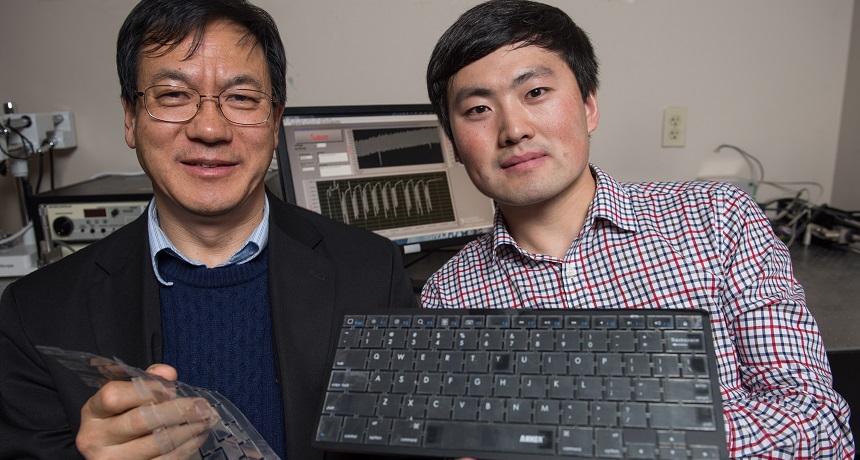This ‘smart’ self-cleaning keyboard is powered by you
The bonus: It works for its owner and no one else

Zhong Lin Wang (left) and Jun Chen (right) of Georgia Tech show their team’s new self-powered keyboard, which can lock out unauthorized users.
Rob Felt, Georgia Institute of Technology
A new keyboard can tell if you’re its owner. It locks out anyone else, even if that person knows your password. What’s more, this device needs no batteries. It harvests all the energy it needs from the action of your typing.
All in all, “This will hugely improve the security of a computer,” predicts Zhong Lin Wang. He’s a materials scientist at the Georgia Institute of Technology in Atlanta and a co-designer of the new keyboard.
“Our fingertips have electrostatic charges,” explains Wang. That means there’s an imbalance of electrons. Your fingertips generally have a slight positive charge. So they have somewhat fewer electrons than the area around them. And that principle makes it possible for typing to induce an electric current in the keyboard, Wang points out.

Wang’s group put two layers of metal electrodes under the keyboard’s plastic surface. When a finger approaches a key, it attracts free electrons to the top electrode. The bottom electrode supplies them. As soon as the finger lifts off of the key, the electrons flow back to the lower electrode. Any flow of electrons creates an electric current.
And this induced electric current can power the keyboard — but only if the current is strong enough. To achieve that, the Georgia Tech team focused on nanotechnology. (“Nano-“ refers to things measured on the scale of 100 billionths of a meter or less.)
The keys of the new keyboard are made of the same inexpensive plastic that might be found on any other standard keyboard. But instead of being smooth, the keys have millions of tiny plastic “nanowires” on their surface. Those nanowires make the new keys special. They add more surface area to every key, increasing the effective contact area between the plastic and the fingers, Wang explains. This ensures that there’s enough power to run the keyboard as someone types.
Because fingers touch the keys and then back off, that current isn’t constant. It also varies with the force and speed at which a typist strikes different keys. And that rate, force and pattern of typing will differ from one person to the next. In much the same way that a voiceprint gives a unique signature to the way each person speaks, typing will give a personal signature to each person’s keyboard use.
What this means, Wang explains, is that “even if the same phrase is typed by three different people, the [electrical] output signals are very different.” Thus, typing can be a type of biometrics — a way to identify people based on unique biological features.
The keyboard records information about the typing pattern and sends it to a program in the computer. The program then checks to see if the pattern matches the right user. If not, an alarm sounds, and the computer locks the typist out.
The new keyboard is also self-cleaning. All the tiny nanowires on the keys repel water, oils and dirt. It’s the same principle that lets a lotus flower float on a lake. The lotus has tiny water-repellant nanobumps covering its leaves.
Liming Dai is a polymer scientist who works with nanotechnology at Case Western Reserve University in Cleveland, Ohio. He did not work on the new keyboard, but he thinks the design could be important in getting better performance from a variety of devices.
“It could also be applied to a touch screen,” for instance, Dai says. Then smartphones and notepads could harvest energy from the motion of someone typing or drawing. And these devices could also benefit from the same keystroke “fingerprint” concept to keep strangers from using them. The smart keyboard might even be made from flexible polymers to create a medical sensor.
Future work might make the keyboard even more useful, Dai adds. A later design might build tiny capacitors onto the nanowires, he suggests. Capacitors are little devices that temporarily store an electric charge. Those might then power light-emitting diodes, or LEDs, to light a keyboard in the dark.
Meanwhile, Wang’s team has built a working prototype of its keyboard. If a company decides to fund its production, this keyboard could be in stores in as little as two years, says Wang.
His group published details on the design of its new keyboard in the January 27 issue of ACS Nano.
Power Words
(For more about Power Words, click here)
atom The basic unit of a chemical element. Atoms are made up of a dense nucleus that contains positively charged protons and neutrally charged neutrons. The nucleus is orbited by a cloud of negatively charged electrons.
battery A device that can convert chemical energy into electrical energy.
biometrics A group of technologies used to identify people on the basis of measuring biological features that are unique to them. Fingerprints are a prime example of a biometric technology.
capacitor An electrical component used to store energy. Unlike batteries, which store energy chemically, capacitors store energy physically, in a form very much like static electricity.
electric charge The physical property responsible for electric force; it can be negative or positive.
electric current A flow of charge, called electricity, usually from the movement of negatively charged particles, called electrons.
electric field A region around a charged particle or object within which a force would be exerted on other charged particles or objects.
electricity A flow of charge, usually from the movement of negatively charged particles, called electrons.
electron A negatively charged particle, usually found orbiting the outer regions of an atom; also, the carrier of electricity within solids.
electrostatic Referring to a condition that exists around an area that has an imbalance of electrons compared to its surroundings. A positive electrostatic charge exists when one surface has fewer electrons than the surrounding area. A negative electrostatic field occurs when there are excess electrons.
induce To produce or cause something to happen. In physics, electromagnetic induction is the production of electricity with varying magnetic fields.
LED (light-emitting diode) A type of semiconductor device that produces light.
magnet A material that usually contains iron and whose atoms are arranged so they attract certain metals
molecule An electrically neutral group of atoms that represents the smallest possible amount of a chemical compound. Molecules can be made of single types of atoms or of different types. For example, the oxygen in the air is made of two oxygen atoms (O2), but water is made of two hydrogen atoms and one oxygen atom (H2O).
nano- A prefix indicating a billionth. In the metric system of measurements, it’s often used as an abbreviation to refer to objects that are a billionth of a meter long or in diameter.
plastic Any of a series of materials that are easily deformable; or synthetic materials that have been made from polymers (long strings of some building-block molecule) that tend to be lightweight, inexpensive and resistant to degradation.
polymer Substances whose molecules are made of long chains of repeating groups of atoms. Manufactured polymers include nylon, polyvinyl chloride (better known as PVC) and many types of plastics. Natural polymers include rubber, silk and cellulose (found in plants and used to make paper, for example).
prototype A first or early model of some device, system or product that still needs to be perfected.
sensor A device that picks up information on physical or chemical conditions — such as temperature, barometric pressure, salinity, humidity, pH, light intensity or radiation — and stores or broadcasts that information. Scientists and engineers often rely on sensors to inform them of conditions that may change over time or that exist far from where a researcher can measure them directly.
smartphone A cell (or mobile) phone that can perform a host of functions, including search for information on the Internet.
technology The application of scientific knowledge for practical purposes, especially in industry — or the devices, processes and systems that result from those efforts.







